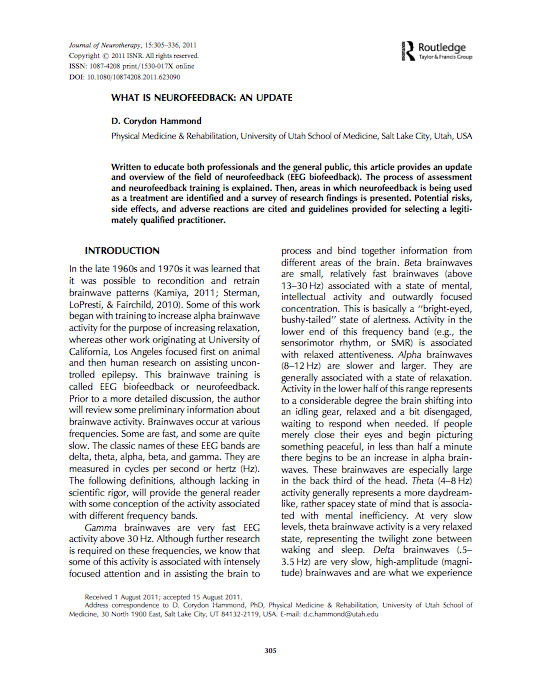The academic literature around the effects of Neurofeedback training (NFT) on different disorders has been maturing in recent years. We look forward to more research, but accumulating evidence found that NFT is a promising treatment for the following conditions: mild traumatic brain injury, ADD/ADHD, learning disabilities, depression, obsessive-compulsive disorder, anxiety, panic disorder, drug abuse, autism, and a variety of other conditions (including schizophrenia, stroke, epilepsy, and dementia). Neurofeedback can also used by people who aim to achieve their peak performance in their professional, creative and physical lives.
Below are some studies on the benefits of Neurofeedback.
Abstract:
Written to educate both professionals and the general public, this article provides an update and overview of the field of neurofeedback (EEG biofeedback). The process of assessment and neurofeedback training is explained. Then, areas in which neurofeedback is being used as a treatment are identified and a survey of research findings is presented. Potential risks, side effects, and adverse reactions are cited and guidelines provided for selecting a legiti- mately qualified practitioner.
Hammond, D. C. (2011). What is Neurofeedback: An Update Journal of Neurotherapy: Investigations in Neuromodulation, Neurofeedback and Applied Neuroscience. 15. 305-336.
Abstract:
BACKGROUND: Neurofeedback is a form of biofeedback whereby a patient can learn to control measurements of brain activity such as those recorded by an electroencephalogram. It has been explored as a treatment for sequelae of traumatic brain injury, although the use of neurofeedback remains outside the realm of routine clinical practice. METHODS: Google ScholarTM was used to find 22 examples of primary research. Measures of symptom improvement, neuropsychological test- ing, and changes in subjects’ quantitative electroencephalogram were included in the analysis. A single reviewer classified each study according to a rubric devised by 2 societies dedicated to neurofeedback research. RESULTS: All studies demonstrated positive findings, in that neurofeed- back led to improvement in measures of impairment, whether subjec- tive, objective, or both. However, placebo-controlled studies were lacking, some reports omitted important details, and study designs differed to the point where effect size could not be calculated quantitatively. CONCLUSIONS: Neurofeedback is a promising treatment that warrants double-blind, placebo-controlled studies to determine its potential role in the treatment of traumatic brain injury. Clinicians can advise that some patients report improvement in a wide range of neuropsychiatric symp- toms after undergoing neurofeedback, although the treatment remains experimental, with no standard methodology.
Balon, R., Benson, R., Boutros, N. & May, G. (2013). Neurofeedback and traumatic brain injury: A literature review. Annals of Clinical Psychiatry. 25(4). 289-296
Abstract:
OBJECTIVE: To evaluate sustained improvements 6 months after a 40- session, in-school computer attention training intervention using neurofeedback or cognitive training (CT) administered to 7- to 11- year-olds with attention-deficit/hyperactivity disorder (ADHD). METHODS: One hundred four children were randomly assigned to receive neurofeedback, CT, or a control condition and were evaluated 6 months postintervention. A 3-point growth model assessed change over time across the conditions on the Conners 3–Parent Assessment Report (Conners 3-P), the Behavior Rating Inventory of Executive Function Parent Form (BRIEF), and a systematic double-blinded classroom observation (Behavioral Observation of Students in Schools). Analysis of variance assessed community-initiated changes in stimulant medication. RESULTS: Parent response rates were 90% at the 6-month follow-up. Six months postintervention, neurofeedback participants maintained significant gains on Conners 3-P (Inattention effect size [ES] = 0.34, Executive Functioning ES = 0.25, Hyperactivity/Impulsivity ES = 0.23) and BRIEF subscales including the Global Executive Composite (ES = 0.31), which remained significantly greater than gains found among children in CT and control conditions. Children in the CT condition showed delayed improvement over immediate postintervention ratings only on Conners 3- P Executive Functioning (ES = 0.18) and 2 BRIEF subscales. At the 6- month follow-up, neurofeedback participants maintained the same stimulant medication dosage, whereas participants in both CT and control conditions showed statistically and clinically significant increases (9 mg [P = .002] and 13 mg [P , .001], respectively). CONCLUSIONS: Neurofeedback participants made more prompt and greater improvements in ADHD symptoms, which were sustained at the 6-month follow-up, than did CT participants or those in the control group. This finding suggests that neurofeedback is a promising attention training treatment for children with ADHD.
Brennan, R., Frenette, E., Perrin, E., Rene, K. & Steiner, N. (2013). In-School Neurofeedback Training for ADHD: Sustained Improvements From a Randomized Control Trial. PEDIATRICS. 133. 483-492
If you would like to learn more about the benefits of Neurofeedback training, reach out to us! We'd be happy to tell you all about it.


